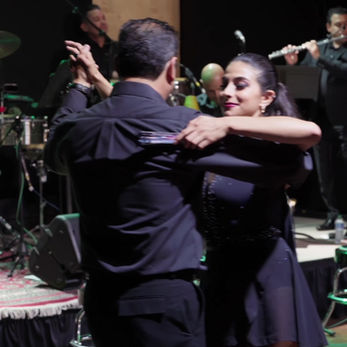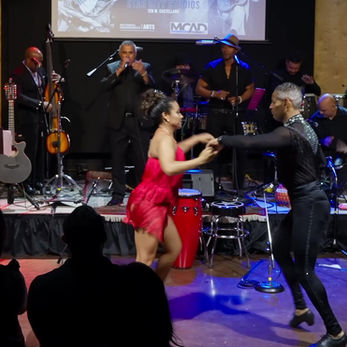top of page

Discover the essence of Cuban music with Mi Cuba. Our project celebrates the evolution of Cuba's unique sound, blending the past and present to showcase the rhythms, instruments, and legends that define our musical heritage. Experience not only the music but also the vibrant dances that bring these rhythms to life, connecting teh auidence to the heartbeat of cuban culture.
Cuba's Rhythms

Afro Cuban
When Spanish ships arrived on the shores of Cuba, they encountered a vibrant indigenous culture inhabiting the island. The Taíno people were the primary ethnic group in the region, and they possessed a rich musical heritage that resonated through their festivities and rituals.
The Taíno people crafted their own musical instruments using natural materials such as reeds, seashells, and conch shells. Instruments like maracas and drums accompanied their songs and dances, creating a symphony that celebrated their connection with nature and the spirits.
The Taíno people crafted their own musical instruments using natural materials such as reeds, seashells, and conch shells. Instruments like maracas and drums accompanied their songs and dances, creating a symphony that celebrated their connection with nature and the spirits.

Danzón
Danzón is Cuba's national dance and one of the island's most elegant genres. emerging in the 19th century, it features a slow, refined rhythm, with couples moving gracefully in sync. Its music, influenced by the French contradanza and son, incorporates flutes, violins, and percussion to create a sophisticated atmosphere.

Mambo
Mambo is a fast-paced and vibrant rhythm that emerged in the 1940s as an evolution of danzón and son montuno. It gained popularity in New York thanks to musicians like Pérez Prado and Tito Puente. Its dance is dynamic and full of turns, with fast footwork and intense interaction between dancers, making it an exciting genre both to perform and dance.

Cha-Cha-Cha
Cha-cha-chá is a danceable rhythm derived from danzón and mambo, created by violinist Enrique Jorrín in the 1950s. It is characterized by a clear, steady rhythm, making it one of the most internationally popular Cuban dances. Its signature sound comes from the güiro and maracas’ rhythmic pattern, while the dance is fluid and elegant, with steps that mimic the “cha-cha-chá” sound.

Son
Son Cubano is the foundation of much of modern Cuban music. It originated in eastern Cuba, blending African and Spanish elements into its syncopated rhythm and call-and-response structure. The dance is lively and rhythmic, marked by the bass’s “tumbao” and the clave pattern, making it infectious and energetic.

Bolero
The Cuban bolero is a romantic and melodic genere focused on passionate lyrics and smooth harmonies. Emerging in the late 19th century , it is a pillar of Latin music. Its dance is intimate and expressive, with slow,
sensual movements that reflect the emotion of the music-perfect for couples looking to connect through dance
sensual movements that reflect the emotion of the music-perfect for couples looking to connect through dance

Rumba
Rumba Cubana is a purely Afro-Cuban genre, born in the neighborhoods of Havana and Matanzas. It is divided into three main styles: guaguancó, columbia, and yambú, each with its own rhythm and dance form. It is characterized by the use of drums, cajones, and the clave, while its dance is expressive, featuring sensual and playful movements between men and women.

Conga
Conga is a festive and energetic rhythm that originated in Cuban carnival celebrations. It is defined by its infectious percussion-driven beat, featuring drums and brass, accompanied by a parade of dancers moving in a line with marked steps and vigorous hip movements. It remains one of the most joyful expressions of Cuban music.

Latin Jazz
Afro-Cuban jazz is the fusion of jazz with Cuban rhythms, pioneered by musicians like Chano Pozo and Dizzy Gillespie. It combines jazz improvisation with the rich percussion patterns of Cuban music, creating a vibrant and sophisticated sound. The dance is free and creative, allowing dancers to play with rhythm and musical interpretation.

Timba
Timba is a modern evolution of Cuban music that fuses son, jazz, funk, and other international genres. Its rhythm is complex and dynamic, with intense variations that allow great freedom in both musical interpretation and dance. Its dance style is spontaneous and full of energy, combining salsa movements with Afro-Cuban influences.

Trailer
bottom of page